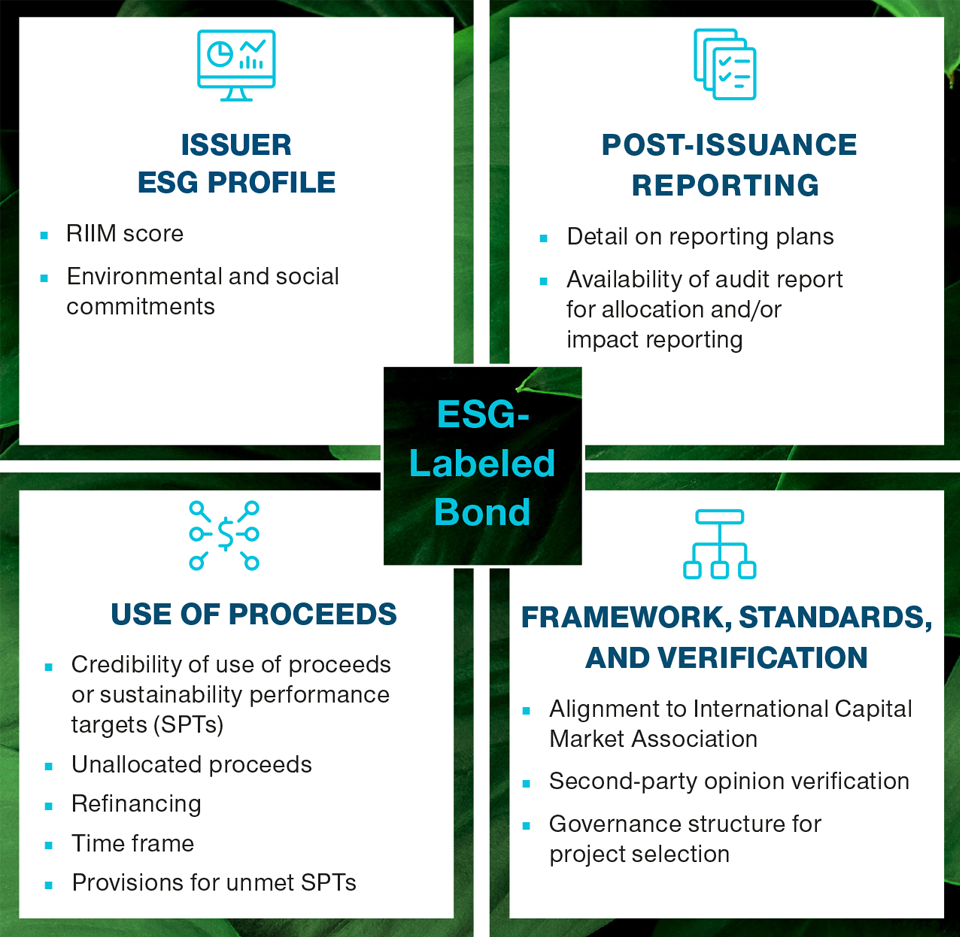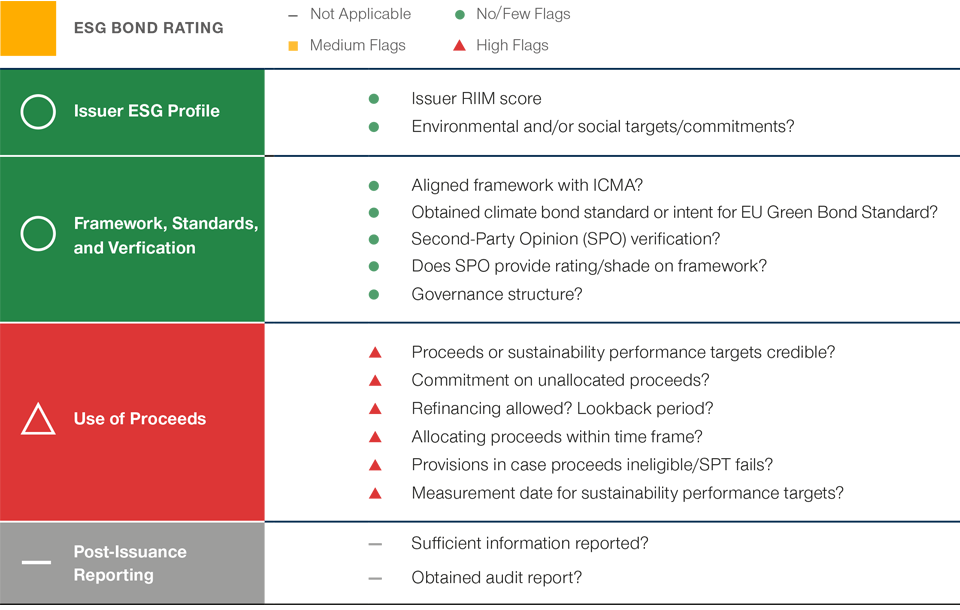June 2022 / FIXED INCOME
Evaluating ESG Bonds—What's Behind the Label
Greenwashing risks underpin importance of assessing an ESG bond’s credentials.
Key Insights
- The market for environmental, social, and governance (ESG)‑labeled debt has grown rapidly, a trend we expect to continue as governments and companies step up their efforts to meet climate and social goals.
- A lack of global compulsory standards and criteria for issuing debt with an ESG‑related tag leaves investors vulnerable to greenwashing, however.
- To help mitigate this risk, we have built a proprietary framework to evaluate the quality and credentials of an ESG‑labeled bond.
The market for debt issued with an environmental, social, and governance (ESG) focus has grown rapidly in recent years to become a significant feature of today’s fixed income investing landscape. While we are encouraged to see companies and governments undertaking green and social projects eligible for ESG‑labeled bond financing, caution is warranted. This fast‑growing, yet still nascent, category has proven vulnerable to greenwashing—where some securities convey a false impression or provide misleading information about the environmental credentials of an organization’s products, services, and investments. Furthermore, not all green, social, sustainability, and sustainability‑linked bonds are created equal or have adequate safeguards in place to ensure that their proceeds will indeed target sustainable activities. For these reasons, we do not feel that it is appropriate to just accept a bond as “sustainable” based solely on its label. A robust ESG bond framework is vital, therefore, to help evaluate the credentials of an ESG‑labeled bond.
Rapid Growth in ESG‑Labeled Issuance Set to Continue
Since the issuance of the first green bond in 2007, the market for sustainable finance has grown considerably and broadened to include social, sustainability, and sustainability‑linked bonds. In 2021, for the first time ever, more than USD 1 trillion worth of bonds were sold for the purpose of either financing specific environmental/social projects (green, social, and sustainability bonds) or for general purposes (sustainability‑linked bonds) where the structure is linked to the issuer’s achievement of a predefined ESG target.
What’s Behind the Label
Understanding ESG‑labeled bonds
| Green | Social | Sustainability | Sustainability‑Linked | |
|---|---|---|---|---|
| Bond Structure | Use of proceeds allocated to environmental projects. | Use of proceeds allocated to social projects. | Use of proceeds allocated to environmental and social projects. | Use of proceeds for general purposes, including a change in the financing condition (e.g., coupon step‑up if sustainability objectives not met). |
| Example of Projects | Renewable energy, energy efficiency, green buildings, clean transportation, wastewater management, climate change adaptation. | Food security and sustainable food systems, socioeconomic advancement, affordable housing, access to essential services, affordable basic infrastructure. | Similar to those in green and social bonds categories. Renewable energy, food security, affordable housing, etc. | Not project based, but structure typically ties to issuer‑level Sustainability Performance Targets. |
Source: T. Rowe Price.
Behind the rapid growth is insatiable demand from investors who are keen to gain exposure to more ESG‑conscious investments. This has led to a so‑called greenium where investors are willing to pay more for an ESG‑labeled bond than the plain-vanilla equivalent, despite both carrying the same level of credit risk. According to T. Rowe Price analysis, investment‑grade ESG bonds denominated in euros typically trade at a premium of around three basis points over vanilla bonds, while U.S. dollar‑denominated ESG‑labeled debt trades, on average, around six basis points more expensive than non‑ESG equivalents.1
Surging investor demand makes ESG‑labeled bonds an increasingly cheaper form of financing and should continue to entice issuers to bring new deals to this market. Furthermore, companies and governments are under growing investor, community, and regulatory pressure to transition toward a low‑carbon economy and improve on issues, such as social inequality. For these reasons, we expect the market for ESG‑labeled bonds will continue to grow.
Wariness About Greenwashing Risks and Materiality
With ESG‑labeled bonds expected to continue growing in both size and complexity, it is critical to understand the various nuances of this market. While ESG‑labeled bonds offer potential new opportunities for investors to diversify and gain exposure to more ESG‑conscious investments, there are several unique challenges in this market.
First, strong investor demand for ESG investments and flexible standards have created an environment that issuers can potentially exploit. For example, there are signs of companies selling ESG‑labeled bonds for environmental/social projects that lack credibility or, in the case of sustainability‑linked bonds, companies set targets that are either easy or have already been achieved.
Second, there is a lack of detail in the principles that companies use as a guide for issuing labeled debt. Although not compulsory, the large majority of companies follow the International Capital Market Association (ICMA) guidelines for issuing each category of ESG debt—the Green Bond Principles, the Social Bond Principles, the Sustainability Bond Guidelines, and the Sustainability‑Linked Bond Principles. These are both vague and lack specific environmental and social project category details. This leaves a lot of room for different interpretations by companies, which raises the risk of potential greenwashing.
Investors Are Paying a Higher Price for ESG‑Labeled Debt
(Fig. 1) Spread of non‑green bonds to green bonds

As of March 31, 2022.
Source: Bloomberg Finance L.P. Analysis conducted by T. Rowe Price.
Third, there’s concern about ESG‑labeled bonds potentially lacking “additionality” or positive ESG impact. For example, issuing a green bond for operational expenditures on renewable energy procurement that was already taking place does not constitute a new green investment nor does it achieve additionality. Another worry is sustainability‑linked bond structures that allow an issuer to recall the bond before its sustainability target measurement date or where the coupon step‑up for missing the target is immaterial.
More Robust Evaluation With a Dedicated ESG Bond Framework
For these reasons, it’s vital to diligently assess an issuer’s ESG credentials when it brings a new bond deal to the market. That’s why we have built a proprietary framework, which helps us evaluate the quality and authenticity of ESG‑labeled bonds. This helps identify “greenwashed” and “social washed” bonds and also helps us ascertain whether we should pay the greenium associated with the security.
As part of our approach, our analysts conduct in‑depth research, including reviewing external resources such as company reports, data, and bond documentation to garner information that could potentially influence our investment decision (either positively or negatively). We also incorporate datasets we have built in‑house, including our in‑house Responsible Investing Indicator Model (RIIM).
Crucially, our framework assesses the credibility of ESG‑labeled bonds across four pillars:
- Issuer ESG Profile
- Framework, Standards, and Verification
- Use of Proceeds
- Post‑Issuance Reporting
First, we evaluate the issuer’s ESG profile by utilizing RIIM, which creates a responsible investing profile for approximately 15,000 companies. We also examine the issuer’s environmental and social future targets at this stage to understand if the issuer has science‑based targets or is aligned with the Paris Agreement carbon targets.
ESG‑Labeled Bonds—Evaluation Framework
Four pillars are key to our assessment

As of April 30, 2022.
Source: T. Rowe Price.
Second, we look for alignment with industry standards. This includes the ICMA principles, the EU Green Bond Standard, and whether the issuer has obtained a Second‑Party Opinion—an independent verification that assesses alignment of an issuer’s ESG bond framework and use of proceeds with the relevant market principles. At this stage, we also examine the issuer’s governance structure that oversees the environmental or social projects financed. Here, a sign of good practice is some form of sustainable finance committee with oversight and responsibility for the project selection process.
In the third pillar, we assess the credibility and ambition of the issuer’s financed project and examine how proceeds will be managed throughout the life of the bond. Here, we have created a proprietary Credibility Guidance Model, which helps us ascertain whether green or social projects are credible across the ICMA’s 10 environmental project categories and six social project categories. Another important area of focus within this pillar is transparency around the lookback period. This is when an issuer is using proceeds to refinance environmental/social projects, they should indicate the number of years that they will look back to for environmental or social projects that are already funded.
For sustainability‑linked bonds, the use of proceeds pillar examines the ambitiousness and materiality of sustainability performance targets, in addition to the target measurement date and the size of the coupon step‑up if these targets are not met.
The final pillar in our framework examines the issuer’s post‑issuance reporting. Here we assess whether the issuer has provided sufficient allocation and impact data in its reporting. We are also looking for whether an external audit report has been obtained by the issuer.
Following our thorough assessment, each pillar is assigned a score, which contributes to an overall score for an issuer’s labeled bond framework. This is displayed in our internal research database, which analysts and portfolio managers can access on their desktop. As illustrated in the ESG Bond Framework Template, a rating of red, orange, or green represents a view on the overall attributes of an issuer’s labeled bond framework.
The quantitative set of scores is an integral part of our evaluation process for ESG‑labeled bonds as it helps us quickly identify positive or negative flags, such as potential greenwashing or a lack of materiality. This score influences whether the labeled bond will make it into a portfolio.
ESG Bond Framework Template
Scoring a corporate issuer’s ESG‑labeled bond framework

The hypothetical example provided is for illustrative purposes only and is not to be construed as investment advice.
Source: T. Rowe Price.
ESG‑conscious investing is now firmly embedded in the fixed income space. But as we have outlined, this strong demand dynamic from investors has created an environment that can be exploited by issuers. These bonds are self‑labeled and lack global enforceable rules, which leaves investors vulnerable to possible greenwashing. That’s why it’s critical that we thoroughly assess each ESG bond through our proprietary framework and use that assessment to inform investment recommendations.
Important Information
This material is being furnished for general informational and/or marketing purposes only. The material does not constitute or undertake to give advice of any nature, including fiduciary investment advice. Prospective investors are recommended to seek independent legal, financial and tax advice before making any investment decision. T. Rowe Price group of companies including T. Rowe Price Associates, Inc. and/or its affiliates receive revenue from T. Rowe Price investment products and services. Past performance is no guarantee or a reliable indicator of future results.. The value of an investment and any income from it can go down as well as up. Investors may get back less than the amount invested.
The material does not constitute a distribution, an offer, an invitation, a personal or general recommendation or solicitation to sell or buy any securities in any jurisdiction or to conduct any particular investment activity. The material has not been reviewed by any regulatory authority in any jurisdiction.
Information and opinions presented have been obtained or derived from sources believed to be reliable and current; however, we cannot guarantee the sources’ accuracy or completeness. There is no guarantee that any forecasts made will come to pass. The views contained herein are as of the date written and are subject to change without notice; these views may differ from those of other T. Rowe Price group companies and/or associates. Under no circumstances should the material, in whole or in part, be copied or redistributed without consent from T. Rowe Price.
The material is not intended for use by persons in jurisdictions which prohibit or restrict the distribution of the material and in certain countries the material is provided upon specific request. It is not intended for distribution to retail investors in any jurisdiction.
USA—Issued in the USA by T. Rowe Price Associates, Inc., 100 East Pratt Street, Baltimore, MD, 21202, which is regulated by the U.S. Securities and Exchange Commission. For Institutional Investors only.
© 2024 T. Rowe Price. All Rights Reserved. T. ROWE PRICE, INVEST WITH CONFIDENCE, and the Bighorn Sheep design are, collectively and/or apart, trademarks of T. Rowe Price Group, Inc.
